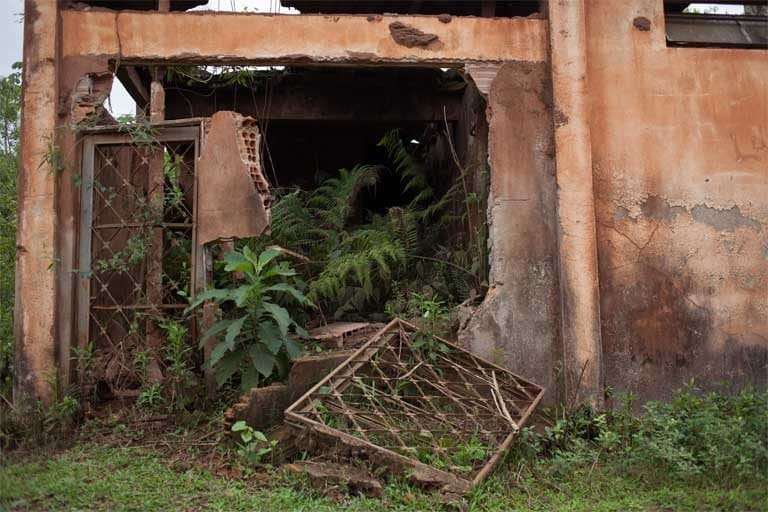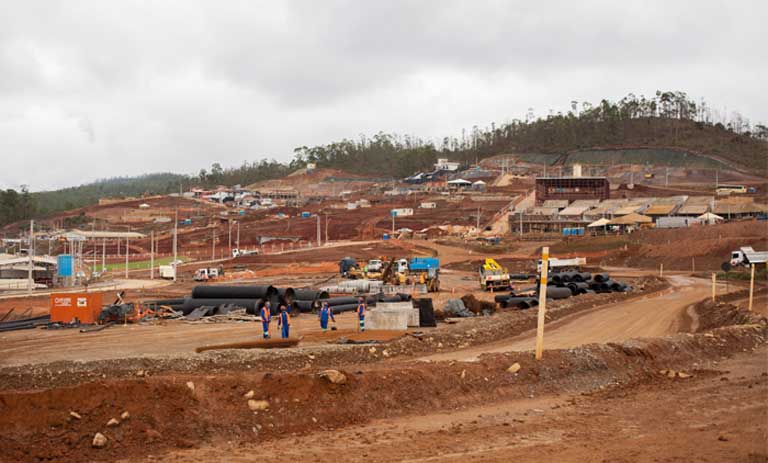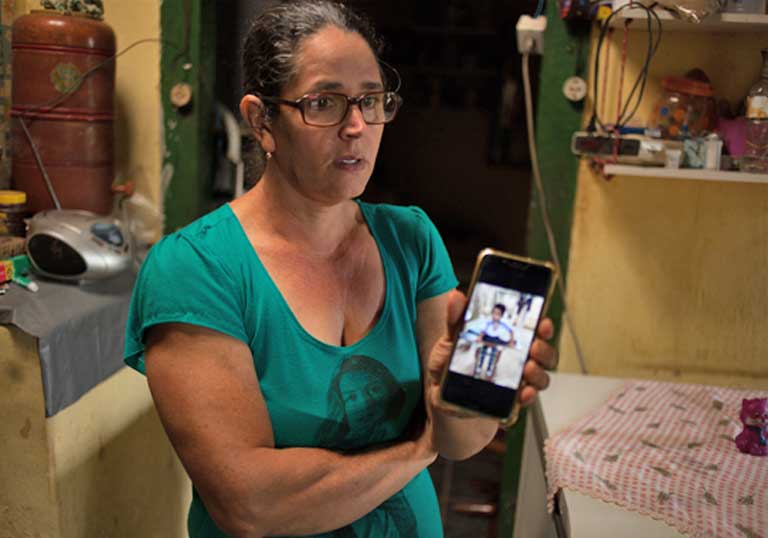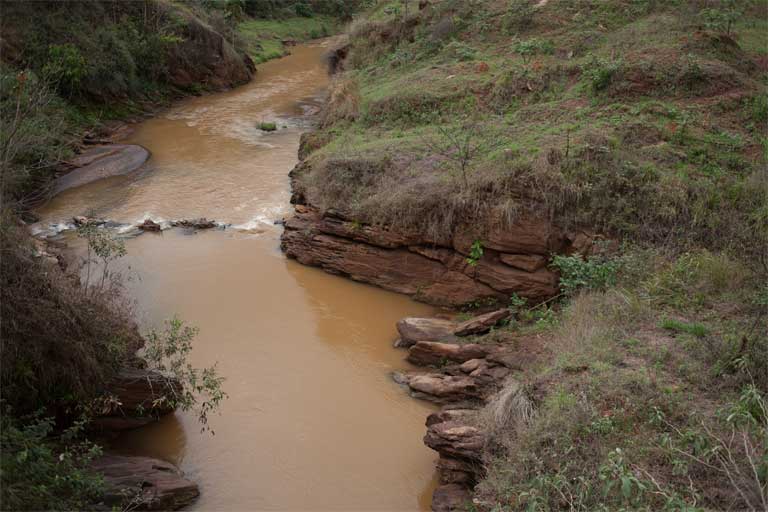- On November 5, 2015, the Fundão iron mine tailings dam failed, pouring 50 million tons of mud and toxic waste into Brazil’s Rio Doce, killing 19 people, polluting the river, contaminating croplands, devastating fish and wildlife, and polluting drinking water with toxic sludge along 650 kilometers (400 miles) of the waterway.
- Five years on, the industry cleanup has failed to restore the river and watershed, according to residents, with fisheries and fields still poisoned and less productive. Access to clean water also remains difficult, while unexplained health problems have arisen, though some cleanup and livelihood projects are yielding hope.
- Rio Doce valley inhabitants remain frustrated by what they see as a slow response to the environmental disaster by the dam’s owner, Samarco, a joint venture of Vale and BHP Billiton, two of the world’s biggest mining companies, and also by the Brazilian government. Roughly 1.6 million people were originally impacted by the disaster.
- The count of those still affected is unknown, with alleged heavy metal-related health risks cited: Maria de Jesus Arcanjo Peixoto tells of her young grandson, sickened by a mysterious illness: ”We’re left in doubt… But he was three months old when the dam burst. And all the food, the milk, the feed for the cows — it all came from the mud.”

The waters of Rio Doce still run a murky reddish-brown just meters away from Adomilson Costa de Souza’s home. Until five years ago, the river was a source of his food and income. Now, it is a daily reminder of the disaster that changed his life.
“I always lived off of Rio Doce,” de Souza said. “Whatever fish I caught, I sold at my doorstep.”
Most months, he netted about 100 kilograms (220 pounds) of fish, selling his catch to customers from hundreds of kilometers around. Beside the river, he raised animals and cultivated banana trees. Most of his neighbors in the village of Pedra Corrida in the Brazilian state of Minas Gerais lived in much the same way.
“For us, who were born here, living alongside the river, the river was everything,” de Souza said. “Then everything came to an end with the tragedy.”
Five years ago this month, millions of tons of toxic sludge gushed from a collapsed iron mining waste dam 300 kilometers (186 miles) upstream from Pedra Corrida. The industrial disaster killed 19 people in the village of Bento Rodrigues, burying them in toxic mud, and adversely affected 39 municipalities across two states. The mining waste eventually flowed more than 650 kilometers (400 miles) from its source to the Atlantic Ocean .
Today, the calamity is considered Brazil’s worst environmental disaster, with responsibility for the dam failure falling squarely on the Samarco mining company, a joint venture of Brazil’s Vale and Anglo-Australian BHP Billiton — two of the world’s biggest mining companies — and on the regulatory failings of the Brazilian government.



A scarred riverine landscape
Across the states of Minas Gerais and Espírito Santo, the red mud flattened hamlets, destroyed homes and contaminated Rio Doce, the region’s most important river. In the catastrophe’s aftermath, some 11 tons of dead fish were pulled from the stream. An estimated 1.6 million people living in the Doce’s watershed were impacted, with the regional economy and livelihoods shattered.
Five years later, adverse impacts linger, with many thousands of people still affected. A thick layer of toxic mud now blankets the Doce’s riverbed and still coats shoreside fields and orchards, leaving water and land tinted reddish-brown from the mixture of mining waste and persistent heavy metals.
“It dealt a huge shock to the region, environmentally and socially, and the recovery has been slow,” said Bruno Milanez, a professor at the Federal University of Juiz de Fora in Minas Gerais and the coordinator of PoEMAS, a research group that studies the political, economic, social and environmental impact of mining.
In Pedra Corrida, people say they don’t dare eat the fish that come from the river and their crops fail to yield as they once did. Many in the village of 2,500 are surviving on a monthly assistance check from Samarco, the Brazilian owner of the collapsed dam.
The tailings dam collapse dealt a heavy blow to de Souza. His banana trees, which grew near the riverbank, dwindled from 1,000 to just 150. The number of fish in Rio Doce has surged back in the years following the disaster — but de Souza and his neighbors no longer fish there.
“Whenever we catch a fish from the river, it’s covered in spots,” he said. “At times, you open it up and it’s all rotten inside. People are scared to buy it. So nowadays, there are no buyers for our fish.”



Stalled recovery
It is still unclear what specifically caused the disaster, but Brazilian authorities, pointing to internal documents, have shown that Samarco and its owners knew the dam could collapse and wreak havoc on the region. The company — still jointly owned by Vale and BHP Billiton — has been ordered to pay billions in environmental clean-up and damages to victims. Twenty-one people, including Samarco CEO Ricardo Vescovi, were also charged with crimes including “qualified homicide” in the collapse, with legal proceedings ongoing. But it seems Brazilian mining giant Vale learned little from the accident, as it failed to prevent a similar dam collapse at Brumadinho, Brazil in January 2019, where hundreds died.
Meanwhile, reparations have been slow to reach Rio Doce victims. The Renova Foundation, set up by Samarco to manage claims related to the disaster, says it has so far allocated about 10 billion reais (US $1.8 billion) towards reparations and compensation for the damage caused by the dam collapse. But a recent UN report found that the company was behind on all of its 42 projects aimed at tackling the industrial accident’s fallout.
Marino D’Angelo Junior is among the thousands who are still awaiting compensation, five years after the wave of toxic mud swept away most of Paracatu de Baixo, the village he called home all of his life. His house was one of the few left intact following the torrent of sludge, but his land was submerged in muck and his crops destroyed.
“When I looked out of my living room window, it seemed like I was on the moon — the landscape was just mud,” he told Mongabay. “We used to live off the land, we always did. It destroyed everything.”
Before the dam collapsed, D’Angelo mostly made a living raising dairy cows. He sold the milk through a producer’s association he headed up, and business was booming: The group’s output surged from 400 liters per day to 10,000 liters in a little over a decade.
“We managed to earn more, to put more money in our pockets,” D’Angelo said. “Then the collapse destroyed half of our producers’ properties. It put an end to everything.”

Long-term risks
As years pass, fears mount among residents over the long-term health impacts of the mining sludge residue that they say still pollutes Rio Doce and covers once fertile lands. The Renova Foundation claims the water and soil in the region are no longer contaminated, but residents in the communities affected say their health is deteriorating and they are falling ill since the disaster.
Studies seem to bear these claims out: In the badly-hit Barra Longa district in Minas Gerais, 77.9% of residents reported unexplained health issues since the disaster, including headaches, coughing, leg pain, and allergic reactions.
“Whoever lives here, doesn’t drink this water, doesn’t eat anything produced in the region,” said de Souza, referring to the community of Pedra Corrida. “So it’s no use saying that it’s all fine, they won’t be able to convince our community.”
In Paracatu de Baixo, the disaster dealt a double blow to Maria de Jesus Arcanjo Peixoto. The torrent of sludge swept through the village she and her family had called home for generations, reducing her home to rubble and blanketing the land where she raised dairy cows with a thick layer of mining waste.
“Crops don’t grow like they used to anymore,” she says, as she wades amid the deep red mud that still abuts the concrete shell that was once her home. “The land was ruined. It’s all just mud now.”
Two years ago, a second disaster struck her family: a mysterious illness attacked her grandson’s lungs and bound him to a wheelchair. “Until now, the doctors didn’t find anything,” Ms. Peixoto said. ”We’re left in doubt; we still don’t know. But he was three months old when the dam burst. And all the food, the milk, the feed for the cows — it all came from the mud.”

The Renova Foundation says extensive treatment of Rio Doce has helped restore water quality, which is now “similar to before the collapse.” The foundation says it collects three million data points at 92 monitoring stations along the river, which have shown no traces of heavy metals or toxic elements in the water.
Yet a recent report from a government environmental agency, which has yet to be made public but which Mongabay obtained from an anonymous source, found elevated levels of a host of metals in Rio Doce and on its river banks, and urged further monitoring of the region’s water and soil.
While Renova has been pouring money into tackling the contamination of Rio Doce, much of the industry-funded foundation’s actions have been “palliative efforts” focused on monitoring the water quality rather than treating the river,according to PoEMAS’ Milanez.
“They are putting a lot of money into these measures,” he said. “But at the end of the day, people are still exposed, the fish are still contaminated. It might be getting better — but is it safe? That’s the big question.”

A new path and hope
The brown currents of Rio Gualaxo do Norte slice gently past the rubble of Bento Rodrigues — the village that stood just below the tailings dam. The town was utterly destroyed by the dam’s collapse, which killed 19 residents and sent the rest fleeing for higher ground just ahead of the torrent of surging mud. Samarco has relocated all the hamlet’s surviving residents, though the traumatizing memories they carry of November 5, 2015 linger.
Now, a local start-up has set out to clean up Rio Gualaxo do Norte, fueling hopes that at least some local environmental damage can be reversed.
A Renova-funded pilot project is using natural plantings to treat the water and regenerate aquatic life in the Gualaxo, one of Rio Doce’s largest tributaries. The same technology has already been successfully implemented elsewhere, including in London, England where it helped clean up the River Thames. Now, it is being tested in Mariana with hopes it can cleanse the immediate watershed.
“This tragedy impacted the whole aquatic environment in a really powerful way,” said William Pessôa, chief executive and founder of LiaMarinha, the start-up that developed the cleanup technology and which has been running the project since August. “But nature has this capacity to regenerate in a natural way. Our aim is to help nature go through this process more quickly.”
The project is still in its infancy, but there are already signs that the plantings are helping reduce heavy metal particles and turbidity in the water, making it clearer and less polluted. “Today, the water has undergone a big improvement,” Pessôa said. “And we see that it has the potential to improve a lot more.”
Communities are finding other innovative roads to recovery. In Pedra Corrida, de Souza has been active in a small aquaculture project for the past three years. He and five other fishermen, who all once made their livings from Rio Doce, now raise fry in unpolluted pools until the fish grow big enough to sell.
“Today, we are raising our own fish and we live from the income we get from selling it,” de Souza said. “And we release some of our fish into the river. We can now give back to nature, instead of taking from it.”
Through this socioeconomic program, de Souza has been able to replace his former income, decimated by the dam collapse. Now, he earns about 2,000 reais (US $365) per month from his aquaculture work.
The Renova Foundation has also spearheaded a larger fisheries project, aimed at replicating these results and broadening the community’s access to aquaculture — a move welcomed by residents still feeling the industrial disaster’s painful impacts.
For de Souza, who is helping expand the aquaculture project, the hope is that it reaches more people in his community, giving them the same chance to rebuild their lives.
“For us, it was a blessing from God — it changed our lives completely,” he said. “We only hope it helps others too.”
Banner image: Marta de Jesus Arcanjo Peixoto stands amid the ruins of her home. Image by Ana Ionova.
The reporting for this story was supported by a grant from the International Women’s Media Foundation.
FEEDBACK: Use this form to send a message to the author of this post. If you want to post a public comment, you can do that at the bottom of the page.

